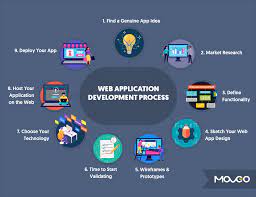Rapid Software Development: Accelerating the Pace of Innovation
In today’s fast-paced digital landscape, businesses are constantly seeking ways to stay ahead of the competition and deliver innovative solutions to their customers. One approach that has gained significant traction is rapid software development. This methodology focuses on accelerating the entire software development lifecycle, from initial concept to final deployment, in order to quickly deliver high-quality software products.
Rapid software development is driven by the need for speed and agility. Traditional software development methodologies, such as the waterfall model, often involve lengthy planning and documentation phases before any coding begins. This can result in slower time-to-market and missed opportunities for innovation.
In contrast, rapid software development embraces a more iterative and flexible approach. It encourages frequent collaboration between developers, stakeholders, and end-users throughout the entire process. By breaking down projects into smaller increments or sprints, teams can deliver functional prototypes or minimum viable products (MVPs) at a much faster pace.
One popular framework for rapid software development is Agile. Agile methodologies, like Scrum or Kanban, emphasize adaptability and responsiveness to changing requirements. They promote cross-functional teams working closely together in short cycles called sprints. These sprints typically last from one to four weeks and culminate in a potentially shippable product increment.
The benefits of rapid software development are manifold. Firstly, it allows businesses to respond quickly to market demands and changing customer needs. By releasing early versions of their products or features, companies can gather valuable feedback from users and make necessary adjustments promptly.
Furthermore, rapid software development promotes better risk management by identifying potential issues earlier in the process. Frequent testing and continuous integration help catch bugs or design flaws sooner rather than later when they are more costly to fix.
Another advantage of rapid software development is increased collaboration among team members. With shorter cycles and constant communication channels established within agile frameworks, developers can work closely with stakeholders to ensure alignment on project goals and expectations. This fosters a sense of ownership, accountability, and shared responsibility for the success of the software product.
However, rapid software development is not without its challenges. The need for speed can sometimes lead to compromised quality if proper testing and quality assurance measures are overlooked. It requires a disciplined approach to ensure that corners aren’t cut in the pursuit of faster delivery.
Moreover, managing changing requirements can be a delicate balancing act. While flexibility is a core principle of rapid software development, it’s important to strike a balance between accommodating changes and maintaining project focus. Clear communication channels and effective project management are essential to keep everyone aligned and prevent scope creep.
In conclusion, rapid software development has revolutionized the way businesses approach software creation. By embracing iterative cycles, frequent feedback loops, and close collaboration among team members, organizations can accelerate their innovation process while delivering high-quality software products. While challenges exist, with proper planning and execution, rapid software development can empower businesses to stay competitive in today’s dynamic digital landscape.
“The Four-Phase Journey of Rapid Application Development Explained”
“The Dynamics of Rapid Application Development: Purpose and Functionality”
4. “Decoding
- What is a rapid approach to systems development?
- What are the 4 phases of rapid application development?
- What does rapid application development do?
- What is rapid development model?
- What is rapid development software?
What is a rapid approach to systems development?
A rapid approach to systems development refers to a methodology that emphasizes speed and efficiency in the process of creating software systems. It involves adopting strategies and techniques that allow for accelerated development cycles, quick iterations, and rapid delivery of functional prototypes or minimum viable products (MVPs). This approach aims to streamline the entire development process, from requirements gathering to deployment, by focusing on iterative development, continuous feedback loops, and close collaboration between developers, stakeholders, and end-users. By embracing a rapid approach to systems development, organizations can respond swiftly to evolving market demands, reduce time-to-market, and deliver innovative solutions in a timely manner.
What are the 4 phases of rapid application development?
Rapid application development (RAD) follows a streamlined approach that emphasizes speed, collaboration, and iterative development. The methodology typically consists of four distinct phases. The first phase is Requirements Planning, where project goals and objectives are defined, and initial user requirements are gathered. This sets the foundation for the subsequent phase – User Design. Here, prototypes or mock-ups are created to visualize the software’s user interface and functionality, allowing stakeholders to provide feedback and make necessary adjustments. The third phase is Construction, where developers start coding based on the approved designs. This phase focuses on rapid development iterations to deliver working software increments. Finally, in the Cutover phase, the software is deployed and tested in a live environment, ensuring its readiness for end-users. These four phases of rapid application development enable teams to accelerate the software development process while maintaining a focus on meeting user requirements and delivering value at each stage.
What does rapid application development do?
Rapid application development (RAD) is a software development methodology that aims to expedite the process of building and deploying applications. It focuses on delivering functional software prototypes quickly by emphasizing iterative development, close collaboration between developers and stakeholders, and the use of visual modeling tools. RAD enables organizations to accelerate their time-to-market by streamlining the entire application development lifecycle. By enabling faster iterations, RAD allows for rapid prototyping, user feedback, and continuous improvement. This approach is particularly beneficial when time is of the essence or when requirements are likely to change frequently. Ultimately, rapid application development enables businesses to swiftly adapt to evolving market demands and deliver high-quality applications efficiently.
What is rapid development model?
The rapid development model is a software development approach that focuses on delivering software solutions quickly and efficiently. It is characterized by its iterative and incremental nature, where projects are divided into smaller phases or iterations. Each iteration involves the development of specific features or functionalities, allowing for faster delivery of working software. The rapid development model emphasizes close collaboration between developers, stakeholders, and end-users throughout the process to ensure that the final product meets their needs and expectations. By prioritizing speed and adaptability, this model enables businesses to respond swiftly to changing requirements and market demands, ultimately accelerating the overall software development lifecycle.
What is rapid development software?
Rapid software development, also known as rapid application development (RAD), is a methodology that focuses on expediting the software development process to deliver applications or products quickly. It emphasizes iterative prototyping, collaboration, and flexibility to meet the evolving needs of businesses and end-users. Rapid development software aims to accelerate time-to-market by breaking down projects into smaller increments or sprints, allowing for faster feedback, testing, and deployment. This approach enables organizations to respond swiftly to market demands, gather user feedback early on, and deliver functional prototypes or minimum viable products (MVPs) in a shorter timeframe. By prioritizing speed and adaptability, rapid development software empowers businesses to stay competitive in today’s fast-paced digital landscape.




